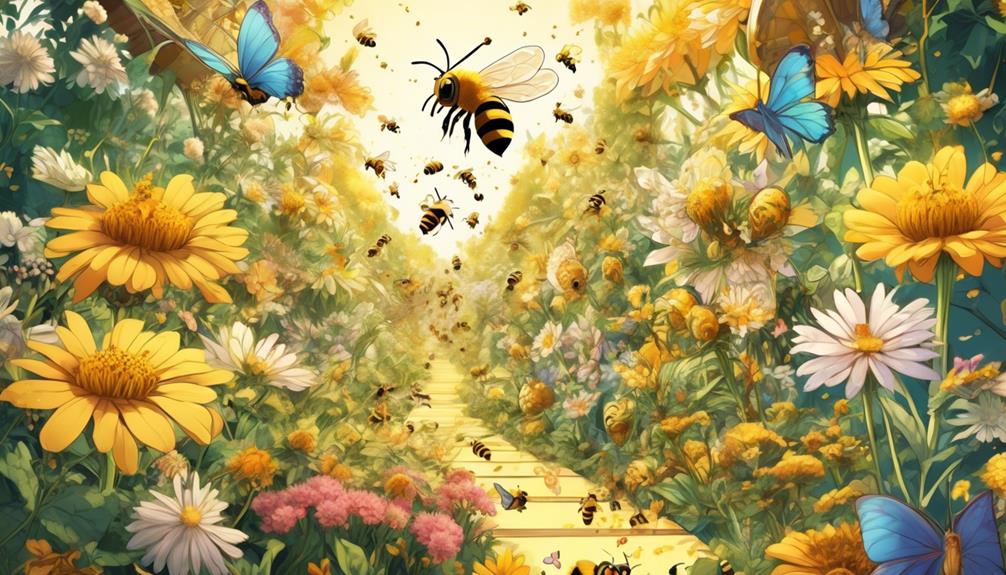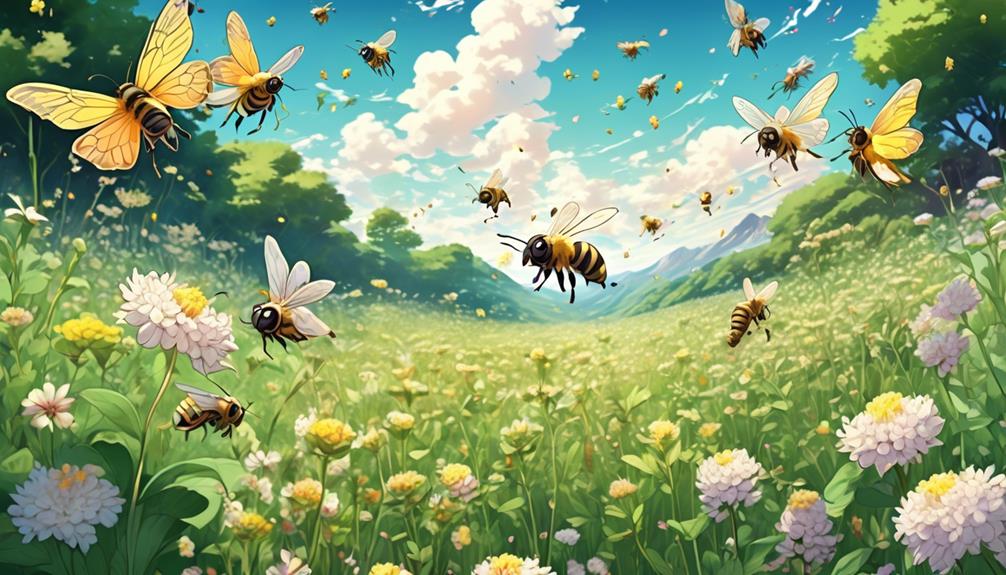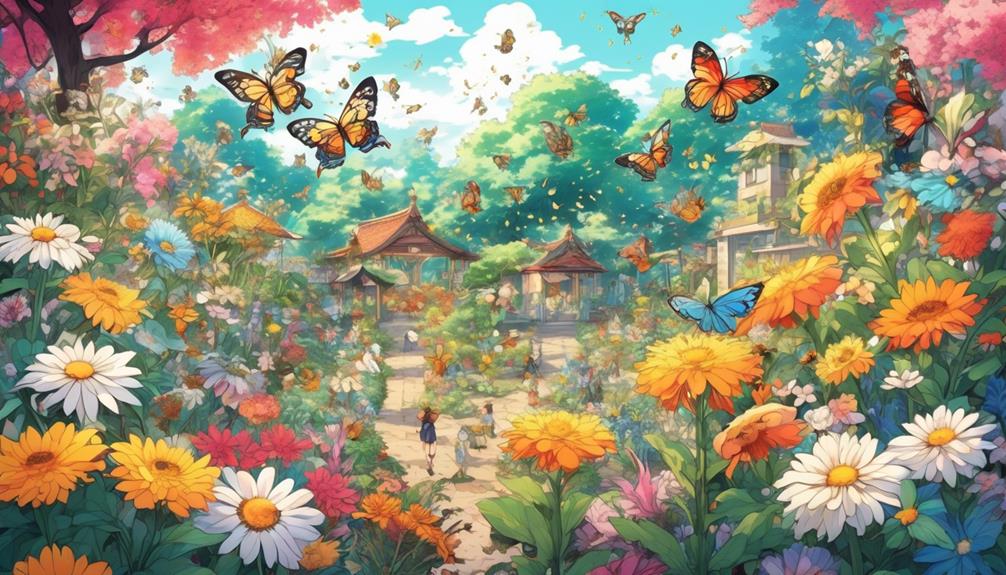Buzz into the fascinating world of bees and butterflies, and discover whether these vital pollinators can truly coexist harmoniously.

Can Bees and Butterflies Coexist?
Bustling bees and beautiful butterflies, both vital to our ecosystem, often share the same habitats. You've probably watched with fascination as they flit from flower to flower, seemingly in harmony. Yet, you might wonder if this apparent peaceful coexistence is the full story.
As you embark on a journey into their world, you'll discover their unique roles, interactions, and the potential impact of competition. But the question still hangs in the air: can bees and butterflies truly coexist harmoniously?
Let's explore this further.
Key Takeaways
- Bees and butterflies are both essential pollinators, supporting the growth of diverse plant species.
- Bees and butterflies can coexist in the same ecological niches, but competition for resources can impact their behaviors and population dynamics.
- Promoting coexistence and conservation involves diversifying garden plants, opting for native plants, avoiding pesticides, encouraging natural predators, and being mindful of gardening practices that may disturb active bees and butterflies.
- The interaction between bees and butterflies is integral to ecosystem diversity and resilience, highlighting the importance of their presence in various climates and environments.
Understanding Bee and Butterfly Biology

To truly grasp the coexistence of bees and butterflies, it's critical to dive into the fascinating intricacies of their biology.
You should be aware that bees, members of the Apidae family, are flying insects closely related to wasps and ants. They're known for their role in pollination, with over 20,000 species worldwide. Notably, they possess a barbed stinger for self-defense and a proboscis, a long thin tongue, to extract nectar.
On the other hand, butterflies, belonging to the Lepidoptera order, are admired for their vibrant colors and patterns. They're equipped with a long, flexible tube called a proboscis to drink nectar, similar to bees but without the stinging mechanism. There are approximately 20,000 species of butterflies globally.
Interestingly, both species share a mutual relationship with plants. They're vital pollinators, transferring pollen grains from the male anther of a flower to the female stigma. This cross-pollination process is integral to plant fertility and food production. However, they differ in their pollinating efficiency. Bees tend to be more effective due to their hairy bodies, which trap more pollen.
Your understanding of these biological distinctions is pivotal in comprehending their coexistence.
Habitats of Bees and Butterflies

Having unraveled the biological intricacies of bees and butterflies, let's now explore their diverse habitats, as this too plays a significant role in their coexistence.
Bees, being versatile creatures, can adapt to various climates and environments, from deserts to forests. They're typically found in areas rich in flowering plants, as nectar and pollen are their primary food sources.
Butterflies, on the other hand, have a narrower habitat preference. They're mainly found in temperate zones and tropical regions, with an affinity for areas abundant in wildflowers. Unlike bees, butterflies require specific host plants for oviposition and larval development.
Despite these differences, there's an overlap in their habitats. Both species can coexist in the same ecological niches, primarily due to their mutualistic relationship with flowering plants. They pollinate these plants while acquiring the nutrients they need. However, changes in these habitats, such as deforestation and urbanization, could disrupt this delicate balance.
In essence, the habitats of bees and butterflies are crucial to their survival and coexistence. Therefore, understanding and preserving these habitats are key to ensuring the continued existence and interaction of these essential pollinators.
Interaction Between Bees and Butterflies

Let's delve into the fascinating dynamics between bees and butterflies, shedding light on how their interactions shape their shared habitats and contribute to the overall health of our ecosystems. You'll find that these seemingly disparate creatures actually engage in a complex dance of mutual dependency.
Bees and butterflies are both essential pollinators. As they move from flower to flower, sipping nectar, they inadvertently transfer pollen, facilitating plant reproduction. Yet, don't think it's a simple, harmonious relationship. Competition for resources occurs, introducing a subtle tension to their interactions.
However, you'll notice an intriguing balance. Bees, often more aggressive, dominate during peak sunlight. Butterflies, with their delicate structures and diurnal inclinations, tend to feed either early in the morning or late in the afternoon when bees are less active. This temporal partitioning allows both species to coexist, despite vying for the same resources.
Researchers have found that this interaction isn't merely incidental; it's integral to ecosystem diversity and resilience. By facilitating plant reproduction, bees and butterflies support the growth of diverse plant species, fostering robust, resilient ecosystems. Understanding this intricate exchange can help you appreciate the delicate balance that nature maintains among its myriad creatures.
The Impact of Competition

Diving deeper into the competitive dynamics, you'll find that the struggle for resources between bees and butterflies significantly influences their behaviors, population dynamics, and the structure of their shared ecosystems. Competition can drive butterflies to explore new habitats, while bees may become aggressive, defending their territory robustly.
To understand this better, let's examine the following table that breaks down the impact of competition on these two species:
Impact | Bees | Butterflies |
|---|---|---|
Behavior | More aggressive | Explore new territories |
Population Dynamics | Potential decrease due to fights | Possible increase due to range expansion |
Ecosystem Impact | Strain on specific resources | Greater biodiversity via pollination |
Adaptation | Enhanced territorial instincts | Development of new survival strategies |
Coexistence | Possible via resource partitioning | Dependent on resource availability |
You'll notice that competition isn't necessarily negative. It can foster adaptation and survival strategies, promoting biodiversity in the ecosystem. However, the key to coexistence lies in resource partitioning and availability. If both species can find a way to share resources without causing strain on their populations, then peaceful coexistence is possible. This delicate balance is crucial to the health and diversity of our ecosystems.
Promoting Harmonious Coexistence

While competition can influence the behaviors and adaptations of bees and butterflies, it's important to focus on strategies that enable these species to coexist harmoniously. You can play a significant role in promoting this harmony by creating an environment that caters to the needs of both.
Firstly, diversify your garden plants. Bees and butterflies prefer different types of flora. Planting a variety ensures that each species finds suitable nectar sources, reducing competition. You'll also want to opt for native plants, as these are more likely to attract local bee and butterfly populations.
Secondly, provide a safe habitat. Avoid using pesticides that can harm these insects. Instead, encourage natural predators to keep pest populations in check.
Lastly, consider the timing of your gardening practices. Bees and butterflies have different activity periods. By understanding their schedules, you can ensure one isn't disturbed when the other is active.
Frequently Asked Questions
What Are the Primary Food Sources for Bees and Butterflies?
You're curious about the primary food sources for bees and butterflies.
Well, bees primarily feed on nectar and pollen from flowers. They're especially drawn to brightly colored ones.
Butterflies, on the other hand, also feed on nectar but some species are attracted to overripe fruit and even dung.
So, while they're both pollinators, their dietary preferences can vary quite a bit.
Fascinating, isn't it?
How Does Climate Change Affect the Population of Bees and Butterflies?
Climate change can greatly impact your bees and butterflies. It shifts their habitats, disrupts their life cycles, and alters their food sources. Warming temperatures cause early blooming, which can mismatch with pollinator activity. Increased rainfall can drown larvae and eggs.
You're seeing a decline in their populations, and it's alarming. Climate change isn't just a human issue, it's a butterfly and bee issue too. It's disrupting their coexistence and threatening their survival.
Can Bees and Butterflies Crossbreed?
No, bees and butterflies can't crossbreed. They're different species with distinct genetic makeups. You see, crossbreeding typically occurs between animals of the same species or closely related species.
Bees and butterflies belong to different families and orders within the insect world. They've different lifestyles, mating habits, and reproductive systems. So, the idea of them crossbreeding isn't biologically feasible.
It's like expecting a bird to mate with a fish. It just won't work.
How Can the Use of Pesticides Impact the Number of Bees and Butterflies?
Yes, you're right to be concerned. Pesticides can severely impact both bees and butterflies. They're often toxic to these insects, causing death or harming their ability to reproduce.
You mightn't realize it, but even low levels can affect their sense of navigation, hampering their ability to find food. This could lead to a decline in their populations, which in turn disrupts pollination, affecting our food supply and ecosystem health.
How Can Humans Help in Increasing the Population of Bees and Butterflies?
Yes, you can help increase the population of bees and butterflies by taking certain actions.
Planting native flowers in your garden is one way to provide these insects with food.
Avoid using pesticides, as they can be harmful to bees and butterflies.
Creating habitats for them, such as bee houses and butterfly puddling areas, can also be beneficial.
In addition to these steps, you can participate in citizen science projects that track the populations of bees and butterflies.
Conclusion
You've explored the fascinating biology and habitats of bees and butterflies.
You've also learned about the intricate interactions between them and the potential impact of competition.
It's clear that these insects can coexist harmoniously, despite occasional competition for resources.
By implementing measures to promote this coexistence, you can contribute to the conservation of these vital pollinators.
So, let's work together to protect and cherish our buzzing bees and fluttering butterflies, ensuring their survival for generations to come.



